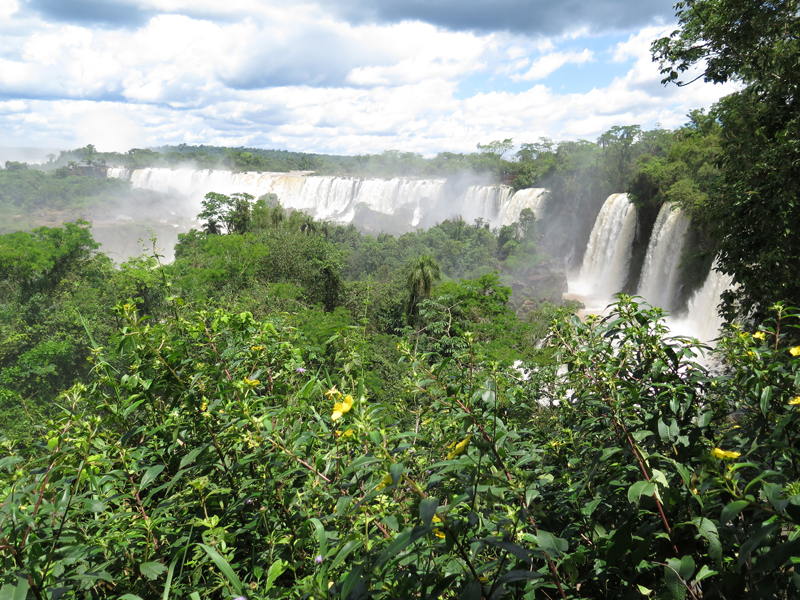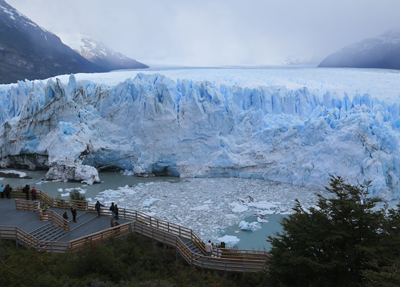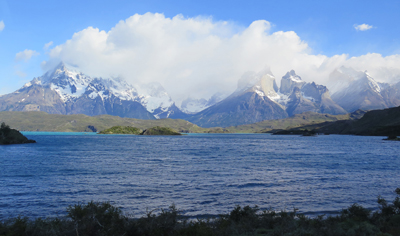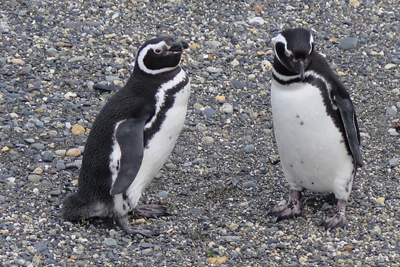Wine, waterfalls and wonderful cuisine – touring Argentina and Chile
This article appears on page 30 of the March 2016 issue.
I have subscribed to ITN for many years but have never written in about my travels. However, I thought my November 2014 tour to South America was a wonderful trip worth knowing about.
Beginning in Buenos Aires
Adventures Abroad’s 21-day tour of Argentina and Chile, with Iguazú Falls ($9,010, single), included breakfasts and dinners, guided touring and all travel except international air. Tips, except to our tour leader, were also included.
I flew nonstop from New York’s JFK to Buenos Aires and arrived ahead of the group. I used that time to check into the hotel, Kenton Palace, located in the Microcentro neighborhood just a few blocks from the main square.
Then I took the metro to the Palermo area to visit the Evita Museum (Lafinur 2988). I spent two hours exploring the life of Eva Perón, then celebrated with a glass of malbec wine in their lovely outdoor restaurant.
The metro was inexpensive and easy to use, and I returned in time to meet the small group of 12 and our very experienced guide, Laura Rudderforth, for dinner.
We left early the next morning with just a day pack (our main luggage was stored at the hotel) for an overnight near Iguazú Falls. We spent the day walking both the upper and lower circuits of the park. The power of the waterfalls was inspiring.
The walkway to The Devil’s Throat was still under reconstruction following damage from the heavy summer rains, so it was inaccessible.
To complete our experience, we all signed on for the optional water adventure (ARS270, or $20) that took us right to the base of the falls. It was a drenching experience that allowed for only about five minutes of photos before all gear had to be stowed in a waterproof bag.
Our hotel in Puerto Iguazú, Hotel Saint George, had an excellent location for exploring the town the next day.
City sights
Back in Buenos Aires, the next day included a driving and walking tour of the main sections of the city. Our morning was spent in Retiro, Palermo and Recoleta, where we explored, on foot, the mausoleum city inside Recoleta Cemetery and paid a visit to the Duarte family for a glimpse of Eva Perón’s tomb.
We had lunch in the La Boca neighborhood, near the colorful El Caminito, where talented local artists and professional tango dancers willing to pose for photos (for a small fee) can be found.
That evening we ate in the historic Café Tortoni, where writer Jorge Luis Borges, among other historic figures, had dined, and we followed that with a wonderful optional tango show ($21) in the showroom below the café. Afterward, the group strolled back to the hotel through the Plaza Mayor and snapped wonderful photos of the illuminated buildings around the square. My favorite view was of La Casa Rosada lit in an almost flamingo-pink color.
On our final day in the city, a local guide walked us through the history of the city and explained the buildings in the Plaza Mayor, led us inside the Metropolitan Cathedral, where the now-Pope Francis had preached, and then took us down into the San Telmo neighborhood, stopping to explore churches, the indoor farmers’ market and old mansions refurbished as antique stores and artist venues.
The afternoon was free for exploring on our own, and a small group of us opted to take a taxi to the Teatro Colón for an English-language tour of this famous landmark (ARS180). There was also a café and shop there — handy during the wait time before the tour.
Later that day we met with Laura for a tasting experience of Pernod (an anise-flavored liqueur) and alfajores (filled cookies) from a local bakery before heading out to dinner. The delicious cookies were essentially two cookies with a thick filling of dulce de leche, but the Pernod (45% alcohol) required cola to offset its somewhat bitter taste.
Bariloche and beyond
We left very early the next day for a flight to Bariloche, in the heart of Argentina’s Lake District, arriving at lunchtime. It was there that I had a fabulous choripán (ARS20), a sort of sausage/hot dog in a bun loaded with a type of salsa, from a street vendor whom our guide knew quite well. It was a perfect outdoor experience!
A tour of the Patagonia museum was a good introduction to the flora, fauna and topography of the area and of the life of the famous explorer and geographer “Perito” Moreno, whose findings, using the sourcing of water from the glaciers, helped in establishing the border between Argentina and Chile.
The town of Bariloche features mostly chocolate shops, but it is located on the edge of a beautiful deep-blue lake, Nahuel Huapi, and faces snowcapped mountains much loved by skiers and hikers. Our hotel, Nahuel Huapi, was fine but perhaps my least favorite of all the hotels on the tour.
Next on the itinerary was a tour of the western circuit along the lake. We rode a chairlift up Cerro Campanario (Belltower Hill) for some stupendous views of snow-topped mountains and deep-blue lakes. We then returned to town for some shopping, local artisanal beer tasting and a wonderful fondue dinner.
That evening, we packed for our all-day border crossing between Argentina’s and Chile’s lake districts.
The day began with a 10 a.m. boat departure from Puerto Pañuelo, located just below the famous Llao Llao resort hotel. Our large bags were tagged and taken on board by porters. This was a blessing, as the crossing required three boat and four bus trips.
The boats were comfortable catamarans managed by TurisTour, with inside seating, a lively bar that served hot chocolate among its selections, and good observation decks.
The border crossing went smoothly; we cleared Argentinean Customs at Porto Frias and Chilean Immigration at Peulla.
My best memories are of the last lake crossing. It took almost two hours to cross the impressive Lake Todos los Santos, with views of snowcapped volcanoes, including the now-dormant Mt. Osorno and the spectacular Mt. Puntiagudo.
We reached Puerto Varas, Chile, at about 7 p.m. for dinner at our lakefront hotel — a surprise upgrade over the Los Colonos hotel listed on our itinerary. This small town was settled in 1853 by families from predominantly Switzerland and Germany, and its streets reflected this charming heritage.
Torres del Paine
We flew south to Punta Arenas early the next morning from the airport at Puerto Montt and began our long drive to Torres del Paine National Park. We stayed inside the park for two nights at the Cabañas del Paine by the Rio Serrano. This was our first experience with southern Patagonia.
Our route crossed the flat Pampas, or grasslands, dotted with scrub bush. Trees were short and bent from the high winds prevalent in the area, where gusts can reach 100kph in the winter.
We passed pink flamingoes, black-necked swans, rheas (ostrich-like birds) and guanacos (small camelids) along the way to the park.
Torres del Paine National Park is considered by many to be Chile’s finest. It is home to eight glaciers, the scenic Paine Massif and a number of deep-blue, glacier-fed lakes.
We were fortunate to have wonderful weather the first day, with a clear view of the powerful granite peaks that rise above Lake Sarmiento, the tallest peak rising nearly 3,000 meters high.
The next day’s itinerary included the Salto Grande, one of the park’s waterfalls, and Grey Lake, studded with icebergs floating down from Grey Glacier above it. The winds were fierce, and it was difficult to cross the beach below the lake, but we managed and it was worth it.
This park is also a major attraction for birders, and we sighted Andean condors, eagles and the famous torrent ducks.
Into Argentina
After crossing from Chilean Patagonia into Argentina, impeded by 117kph winds (as clocked by our bus driver), our group arrived in El Calafate, our next stop for three nights.
Located near Lake Argentino, this resort-style town with trekker shops and a lively artisans’ market is the gateway to the Patagonian ice fields in Argentina. This includes the world-famous Perito Moreno Glacier, made accessible by a series of catwalks and noted for its calving-ice shows and massive advancing face that stands more than 60 meters above the waterline. The glacier’s fantastic blue color reflects the lack of air in the well-compressed ice.
We learned more about how glaciers form by visiting the privately managed Glaciarium, a wonderful new interactive museum located very close to town.
We also paid an optional fee (entry, ARS140) to visit the ice bar, located below the museum, and thoroughly enjoyed the ice sculptures inside as we strolled around dressed in hooded insulated capes, with gloves, for our allotted 25 minutes.
The following day, we departed Puerto Bandera by boat to visit the nearby Upsala Glacier. Below its snout were huge icebergs the size of small buildings.
Our 4-hour cruise included a close-up view of the Spegazzini Glacier.
It was hard to remain outside for long periods of time with the cold winds that were coming off the glaciers, but the comfortable space inside, including a café, made it easy to warm up between the icy blasts.
November is a windy time of year, and, while less crowded with tourists, it demands layers of warmer clothing than does the peak travel season in January and February.
Our hotel in El Calafate, Quijote, was well located and convenient to some wonderful restaurants selected by our tour leader. It was there that we visited the parrillas, where they display roasted meats in the windows. The meat was very tender, but the servings were huge!
We finished our visit to southern Argentina with a quick flight to the port city of Ushuaia. There we visited Tierra del Fuego National Park, the end of the Pan American Highway and the fabulous Beagle Channel.
My best memory from this trip is of the narrated boat ride on the channel and our sightings of two types of penguins, white-and-black cormorants, sea lions and more. We were lucky to have superb weather that day.
Our day was enhanced by a visit to the Maritime Museum and Old Prison, where we learned about the history of the native people, the prisoner colony founded there and the results of the many explorations conducted by Darwin, among others.
Our hotel, Arakur, was another surprise upgrade. Apparently, as a small tour group, we were easier to discommode when overbookings occurred.
The hotel was relatively new, with wonderful amenities and décor. Its only downside was its remote location, 15 minutes outside town.
Be prepared for the hilly streets of downtown Ushuaia and the stepped sidewalks that lead down to the harborfront and back up.
Moving on to Mendoza
Our flight back to Buenos Aires left about 8 p.m. and arrived at the city’s domestic airport by midnight. We checked into our hotel only for the night, departing at 5 a.m. for the next morning’s flight to Mendoza. This was the biggest downside of the trip, in part dictated by the restricted hub-and-spoke nature of flights in Argentina.
Mendoza is the heart of Argentina’s wine country, and the surrounding valleys are home to the famous malbecs enjoyed around the world. Mostly a domestic product until the early 1990s, these wines are now produced using the latest modern technology.
We toured several vineyards south of Luján de Cuyo and enjoyed a fabulous lunch with paired wines and a view of the snowcapped Andes in the distance.
The town of Mendoza contains little of its original Spanish colonial architecture, as much was destroyed by earthquakes, but it does have charming town squares. My favorite was Plaza España, with its colorful tile work.
The town’s outstanding artisan market was perfect for an evening stroll in the well-lighted Plaza Independencia.
Our hotel, Huentala, was a fine choice and convenient for exploring on foot during free time.
Crossing into Chile
We made our last border crossing through the Andes into Chile to reach Santiago, the stop for our final three nights. We traveled in assigned seats on a bus run by Andesmar, which provided fruit juice, cookies and sandwiches for the 7-hour trip. It was very comfortable, and the views of the sierras by the town of Uspallata were truly polychromatic.
The border crossing lasted over an hour and was a bit tedious, as they unloaded all of the luggage and some bags were opened and searched. We used the last of our pesos at the snack shop while waiting.
The road had marked hairpin turns and a number of avalanche sheds as we descended slowly into Chile. We arrived at hotel Diego de Velázquez, in the Providencia section of Santiago, almost 3½ hours later at about 5 p.m.
Valparaíso and Viña del Mar were reached by tour bus the next day. The local guide was perhaps one of the least informative we had on the tour. Most were quite good, and Laura could easily fill in the gaps.
The port of Valparaíso, founded by the Spanish in 1536, is built into more than 40 hills. Located near the top of one of the hills is La Sebastiana, the former home of the Nobel prize-winning poet Pablo Neruda. It is now a museum, complete with his furnishings, including a carousel horse in the living room to remind all that playing is not just for children. The jacaranda trees were flowering in the garden below, and the view of the harbor was lovely.
The town has become a bit rundown since they built a newer deep port 6 miles away, but it is still the home of the Chilean Navy, marked by a lovely colonial building on the harborfront.
Viña del Mar is a beach resort town with a walkable oceanfront promenade, which was perfect for a late seafood lunch.
Santiago
Our final tour day was spent in the city of Santiago. We started with a show in front of La Moneda, the presidential palace — the changing of the guard, marked by band music and horse and foot guards.
We then walked the main square, Plaza de Armas, with its colonial buildings, but there was construction going on in the square, which I found distracting.
The nearby National Museum of History was worth a quick visit during our free time, but the gem was the Pre Columbian Art Museum, located just steps away. My favorite exhibit displayed the Chinchorro mummies that were found in arid northern Chile.
Our final dinner was in the city’s Bellavista area. Once again, Laura did a fabulous job of ordering for the group and ensuring we really tasted and experienced the local flavors.
This was a demanding 21-day tour, which I followed with a private 5-day/4-night visit to Easter Island, also arranged by Adventures Abroad (Richmond, BC, Canada; 800/665-3998, adventures-abroad.com).
Just a 5-hour flight from Santiago, the extension was a great way to end my exploration of Argentina and Chile. (That package, which cost approximately $2,400, included breakfast and dinner, my stay at the Iorana Hotel and three guided group tours.) My international and Easter Island LAN Chile flights were well coordinated by Adventures Abroad.
I have traveled with Adventures Abroad several times, and this was one of the best trips I have taken with them.




